Top AWS WAF Alternatives for Enhanced Security


Intro
In the digital landscape, securing web applications is vital for businesses of all sizes. As organizations increasingly rely on cloud services, solutions like AWS Web Application Firewall (WAF) have gained popularity. However, AWS WAF may not always align with the specific needs of every business. Therefore, exploring alternatives to AWS WAF becomes essential for enhancing security and maintaining robust application performance. In this article, we will delve into various alternatives available in the market, providing a thorough evaluation of their features, performance, pricing, and overall suitability for diverse business requirements. This exploration aims to equip decision-makers with the insights necessary to make informed choices that align with their organizational objectives.
Let’s start by examining the key features of these alternate solutions, focusing on core functionalities and unique selling points.
Key Features of the Software
Overview of Core Functionalities
When evaluating alternatives to AWS WAF, it is crucial to identify core functionalities that enhance application security. Most tools provide basic features like IP blocking, request filtering, and security rules management. Some notable alternatives also include advanced capabilities such as:
- DDoS Protection: Protect against Distributed Denial of Service attacks, which can severely disrupt service availability.
- Bot Mitigation: Identify and block malicious bots, preventing automated attacks on web applications.
- Real-time Analytics: Gain insights into traffic patterns and security threats through comprehensive analytics dashboards.
Unique Selling Points
Different security tools bring unique value propositions to the table. For example, tools such as Cloudflare offer streamlined integration with content delivery networks (CDNs), enhancing both security and performance. On the other hand, solutions like F5 Advanced WAF provide in-depth application security features that cater specifically to complex enterprise environments.
Understanding these unique selling points helps businesses find a solution that meets their specific security needs and integrates seamlessly with their infrastructure.
In-Depth Software Analysis
When choosing an alternative to AWS WAF, an in-depth analysis of each solution is necessary to determine which option best fits the organization's requirements. This analysis includes considering the pros and cons of each tool along with relevant performance metrics.
Pros and Cons
Every solution comes with its benefits and drawbacks. Here are some common pros and cons to consider:
- Pros of Alternatives:
- Cons of Alternatives:
- Scalability: Many alternatives are designed to scale easily with growing traffic demands, making them suitable for SMBs to large enterprises.
- Customizability: Some tools offer customizable security policies, enabling tailored protection based on specific business needs.
- Complexity: Certain solutions may require advanced configuration and management, which could challenge teams without adequate expertise.
- Cost: Depending on the features and level of service, pricing may vary significantly, with some tools appearing more expensive than AWS WAF in certain scenarios.
Performance Metrics
To assess the performance of various alternatives, businesses should consider metrics such as:
- Latency Impact: Evaluate how the security solution affects application response times.
- Threat Detection Rates: Measure the effectiveness of the tool in identifying and blocking real threats.
- Uptime Guarantees: Ensure that the alternative provides reliable service continuity to avoid disruptions.
"A comprehensive analysis helps businesses make informed decisions when selecting security solutions that align with their objectives."
Prelude to Web Application Firewalls
In the contemporary digital landscape, the security of web applications has become paramount. Cyber threats are increasingly sophisticated, targeting vulnerabilities of applications that handle sensitive data. In this context, Web Application Firewalls (WAF) play a critical role. They serve as a protective barrier between web applications and potential attacks, ensuring data integrity and confidentiality. Understanding the function and importance of WAF is essential to grasping the various alternatives available on the market.
Definition and Purpose of WAF
A Web Application Firewall is a security system designed to monitor, filter, and protect web applications from malicious traffic. It operates by analyzing HTTP/HTTPS traffic between the web user and the application, identifying potential threats such as SQL injection, cross-site scripting (XSS), and DDoS attacks. The WAF functions at the application layer, making it capable of understanding the content of requests and responses.
The primary purpose of a WAF is to prevent data breaches and ensure compliance with security standards. Organizations are under continuous pressure to protect user data, making WAFs an indispensable component of any cybersecurity strategy. By implementing a WAF, businesses can mitigate the risks associated with web application vulnerabilities effectively.
The Role of WAF in Modern Security Architecture
In today’s security architecture, the role of WAF extends beyond mere traffic filtering. It acts as a crucial element in a multi-layered security approach. Organizations often combine WAFs with other security measures, such as intrusion detection systems (IDS) and secure web gateways, to enhance their overall security posture.
Here are several key functions that highlight the role of WAF in modern security:
- Threat Detection: WAF systems continuously learn from traffic patterns and adapt to emerging threats. They utilize various techniques like signature-based and behavior-based detection methods.
- Traffic Monitoring: WAFs not only defend against attacks but also provide insights into traffic patterns, helping organizations identify unusual activities.
- Compliance Assurance: Many regulatory frameworks require adequate measures for protecting sensitive information. WAFs assist in meeting these compliance mandates by offering logging, reporting, and monitoring capabilities.
- Custom Rules: Organizations can configure custom rules tailored to their unique requirements, enabling better protection based on specific threats relevant to their applications.
In summary, Web Application Firewalls are essential to modern digital security architecture. They provide a layered approach to protect web applications from multifaceted threats, ensuring organizational resilience against cyber attacks. The subsequent sections will further explore AWS WAF and its alternatives, guiding businesses in choosing the right tool for their specific needs.
Understanding AWS WAF


Understanding AWS WAF is crucial for organizations considering or currently using this web application firewall. It provides insights into how AWS WAF operates, its capabilities, and its inherent shortcomings. This knowledge enables businesses to make better decisions when evaluating alternatives. Grasping the nuances of AWS WAF helps organizations assess their security posture in relation to their web applications, and aligns their strategies with actual needs and expectations.
Overview of AWS WAF Features
AWS WAF boasts various features that cater to the needs of modern web applications. It provides a customizable set of rules designed to filter malicious traffic, creating a protective barrier against common threats such as SQL injection and cross-site scripting. Key features include:
- Customizable Rules: Users can create their own rules tailored to specific security requirements.
- Integration with AWS Services: AWS WAF works seamlessly with other AWS offerings like Amazon CloudFront, ensuring that data is well protected across the board.
- Real-time Metrics: Companies can access real-time traffic data, which helps in assessing threat levels and adjusting defenses accordingly.
- Bot Control: AWS WAF allows users to enforce bot management, reducing automated abuse and ensuring legitimate user traffic is prioritized.
The wide range of features empowers organizations to maintain a higher level of security for their web applications. It also illustrates the flexibility that AWS WAF offers to businesses aiming to safeguard their online resources. However, understanding its limitations is equally important.
Limitations of AWS WAF
Despite its strengths, AWS WAF does have limitations that organizations must consider.
- Cost: Although it is cost-effective for some, it may become expensive for businesses with significant traffic or extensive rule sets.
- Complexity: Configuring AWS WAF can be complicated, particularly for those without prior experience in web application security.
- Limited Feature Set: While it provides essential functionalities, AWS WAF may lack some advanced capabilities found in other specialized web application firewalls.
- Vendor Lock-in: Businesses heavily invested in AWS may find it challenging to transition away from AWS WAF, limiting their options in the future.
Reasons for Seeking Alternatives to AWS WAF
When organizations consider their web application firewall (WAF) needs, AWS WAF often comes to mind due to its integration with other Amazon services. However, there are various reasons why businesses seek alternatives to this solution. The factors can range from cost to specific performance requirements, or even unique feature demands.
Cost Considerations
Cost is frequently a primary factor when evaluating WAF solutions. AWS WAF utilizes a pay-as-you-go pricing model, which can become expensive as usage scales. Though this can be cost-effective for smaller applications, it does not always align with the financial strategies of small to medium-sized businesses aiming for predictable budgeting. Alternatives like Cloudflare WAF or Imperva WAF offer different pricing models, which may provide better alignment to particular business needs.
In many cases, companies can identify less expensive options that provide better overall value at comparable performance levels. This encourages many decision-makers to explore solutions that can minimize their overall expenditure on security without sacrificing functionality or protection.
Performance Issues
Performance plays a crucial role when selecting a WAF. AWS WAF, while effective in many scenarios, can experience latency that may affect application response times. For businesses relying on rapid data transmission, like e-commerce, this could result in lost revenue or a poor customer experience. Other providers may offer optimizations that ensure lower latency and higher throughput, making them more attractive options. This has particularly sparked interest in solutions like F5 Silverline WAF, known for its impressive performance metrics.
Moreover, businesses face different peak loads, and not all WAFs can adapt effectively to traffic variability. This performance inconsistency drives the need to find alternatives that assure stability and speed.
Feature Gaps and Customization Needs
Many organizations may find AWS WAF lacking in certain advanced features needed for their specific environments. For example, some businesses require more granular control over their firewall rules or specific integrations with other security tools. While AWS WAF provides a solid base, the lack of specific customization options can hinder its effectiveness in more complex infrastructures.
In contrast, alternatives like Akamai Web Application Protector and Sucuri Web Application Firewall offer enhanced features such as advanced bot detection or full application scanning. These capabilities can allow businesses to tailor their security measures to their exact requirements. Thus, the search for feature-rich options is pertinent, as securing web applications becomes an increasingly complex undertaking.
Key Criteria for Evaluating WAF Alternatives
When assessing alternatives to AWS WAF, it is essential to have a clear set of criteria. This ensures that the chosen solution aligns well with your organization’s specific needs and operational goals. Evaluating WAF alternatives on multiple dimensions allows decision-makers to make informed choices that take into account both current requirements and future scalability.
Security Features and Protocol Support
The primary function of a web application firewall is to provide robust security against various online threats. Therefore, the effectiveness of a WAF alternative largely depends on its security features. Key considerations include the types of attacks it can prevent, such as SQL injection, Cross-Site Scripting (XSS), and DDoS attacks.
Moreover, the alternative should support various protocols such as HTTP, HTTPS, and WebSocket, as these are the primary transport mechanisms for web traffic. Additionally, integrations with other security tools, like intrusion detection systems (IDS) and threat intelligence platforms, can enhance the overall security posture. A comprehensive security feature set ensures better protection for applications and sensitive data.
Ease of Use and Integration
The usability of a WAF solution can significantly affect its effectiveness. A firewall that is difficult to configure or monitor can lead to misconfigurations, leaving applications vulnerable. Thus, evaluating the user interface is crucial. Look for solutions that offer intuitive dashboards, straightforwardlog management, and clear reporting capabilities.
Integration with existing systems is another vital aspect. The alternative should seamlessly work with the organization's current infrastructure, such as cloud services or on-premise data centers. This reduces the burden on IT teams and speeds up deployment.
Scalability and Performance Metrics
As businesses grow, their security needs evolve. Scalable WAF alternatives allow organizations to adjust their security measures based on traffic load and web application demands. When evaluating scalability, it is important to consider how well the solution can handle traffic spikes without degrading performance. Metrics such as latency, throughput, and the ability to handle concurrent connections are critical.
Monitoring tools that provide performance insights can assist IT professionals in ensuring that the solution remains optimal as usage patterns change. A responsive WAF provides peace of mind, knowing it can keep pace with growth.
Pricing Models and Licensing
Cost is a significant factor for any small to medium-sized business. It is vital to understand the pricing structure of each WAF alternative. Some offer pay-as-you-go models, while others follow a subscription-based model. Knowing the total cost of ownership, including hidden fees for data transfers or additional support, is necessary to avoid unexpected expenses. Also, assess whether the features provided match the cost, to decide if it is wise investment.
Different licensing options – like per site, per user, or tiered services – can affect decision-making. An adaptable pricing model allows greater flexibility for businesses operating on limited budgets.


"A well-defined evaluation criterion empowers businesses to select a WAF that not only meets their current needs but is adaptable for future growth."
By considering these key elements, organizations can make informed choices when exploring AWS WAF alternatives.
Comprehensive Review of AWS WAF Alternatives
In the realm of web security, a thorough review of AWS WAF alternatives is crucial for businesses looking to bolster their defenses. This section provides a clear framework for understanding various options on the market, noting how they differ from AWS WAF. By exploring these alternatives, organizations can identify solutions that fit their unique security needs.
Key elements of a comprehensive review include an assessment of features, usability, and pricing models. This evaluation not only highlights the strengths and weaknesses of each alternative but also helps decision-makers align their choices with the broader goals of their organization.
Cloudflare WAF
Key Features
The Cloudflare WAF is acclaimed for its robust security mechanisms, including a set of predefined rules and the capability for custom rules that cater to specific application requirements. Its ability to integrate across various systems makes it a popular choice. A standout aspect of Cloudflare's offering is its real-time updating feature. This ensures that the firewall can adapt to new threats swiftly. However, some users may find that extensive customization requires a deeper knowledge of web security.
Pricing Structure
Cloudflare’s pricing structure is generally tiered, enabling businesses to select a plan that aligns with their needs. The free version offers essential protections, while premium plans unlock advanced features. This flexibility makes it an appealing option for small to medium-sized businesses looking for cost-effective solutions. Yet, the scalability of the higher-priced plans can become quite steep.
Performance Analysis
Performance-wise, Cloudflare WAF is lauded for low latency and quick load times, attributes that are increasingly important. The unique feature of a global network of data centers enhances performance, but some users have noted occasional inconsistencies during peak loads. This evaluation indicates that, while mostly reliable, performance can fluctuate based on demand.
Imperva WAF
Security Capabilities
The Imperva WAF presents robust security capabilities that protect against a variety of threats. Its comprehensive coverage of OWASP Top Ten risks makes it a beneficial choice for organizations focused on meeting strict compliance standards. A unique feature is its machine learning algorithms, which enhance threat detection. However, these advanced capabilities can lead to false positives.
User Experience
User experience with Imperva tends to be mixed, as some find its interface less intuitive compared to competitors. Nonetheless, the in-depth reporting features provide valuable insights into security events, aiding IT professionals in tracking and managing incidents effectively. This complexity can be a downside for less technical users.
Cost Evaluation
Imperva tends to be on the higher end of the pricing spectrum, which might deter small businesses. Its pricing evaluates not only the software itself but also the bandwidth and data processed, potentially leading to higher overall costs. It offers a rich feature set for the price, but organizations with limited budgets may find it challenging.
F5 Silverline WAF
Integration Options
F5 Silverline WAF excels in integration capabilities, allowing easy connectivity with existing infrastructure and third-party applications. This seamless integration is vital for organizations aiming for continuity. However, its reliance on particular configurations may pose challenges during deployment.
Performance Insights
Performance insights gleaned from F5 Silverline indicate strong resilience against DDoS attacks. Its auto-scaling feature ensures stable performance even during traffic spikes. This is a significant advantage, although the complexity of managing configurations can lead to difficulties for less skilled IT teams.
Market Positioning
In terms of market positioning, F5 Silverline is recognized as a premium solution, often favored by large enterprises. The unique feature of customizable deployment options differentiates it in the market. However, this positioning also signifies a high price point, which may not be suitable for all businesses.
Akamai Web Application Protector
Feature Overview
Akamai's Web Application Protector boasts a wide array of features, including bot management and application layer DDoS protection. The key characteristic here is its content delivery network (CDN) integration, enhancing both security and performance. However, the complexity of setup can be a hurdle for new users.
Scalability Metrics
Scalability is another strong point for Akamai. Many businesses find its services can grow along with their demands without a significant drop in performance. The price, however, can ramp up quickly as usage increases, which requires careful budgeting.
Cost-effectiveness
When evaluating cost-effectiveness, Akamai's pricing might be a barrier, particularly for smaller organizations. While it provides excellent support and features, the total cost can escalate, which some might find prohibitive. Still, for businesses that require robust security features, it might justify the investment.


Sucuri Web Application Firewall
Operational Features
Sucuri WAF delivers essential operational features that focus on malware detection and site monitoring. Key characteristics like real-time performance metrics allow businesses to track their security postures effectively. Some users might find that the breadth of features comes at the cost of a steeper learning curve.
Customer Support
The strength of Sucuri lies in its customer support, which is noted for fast response times and helpful resources. This can be critical for organizations without extensive in-house expertise. The downside, however, is that varying support levels can depend on the pricing plan a customer selects.
Pricing Analysis
The pricing for Sucuri is positioned to attract smaller businesses looking for comprehensive protection without excessive cost. Uniquely, Sucuri offers both monthly and annual payment options, providing flexibility. Nevertheless, users should be mindful of limitations in features tied to lower-tier plans.
Transitioning from AWS WAF to Alternative Solutions
Transitioning from AWS WAF to alternative solutions is a pivotal consideration for organizations that realize the need for specialized web application security. As digital threats evolve, businesses must assess if their current defenses meet their unique requirements. Moving from one solution to another can seem daunting. However, knowing the right steps and implementing effective strategies can ease this process.
The main benefit of transitioning is finding an alternative that aligns more closely with operational goals and security needs. Each organization has distinct requirements shaped by its specific use cases, traffic patterns, and resources. Therefore, spotting gaps in AWS WAF’s features can lead to pursuing tailored solutions that might offer superior performance or additional functionalities.
When considering a migration, businesses should reflect on several key elements. These include the compatibility of the new system with existing infrastructures, potential downtime during the transition, and the learning curve associated with unfamiliar tools. Each of these factors is crucial to ensure a smooth and effective migration that minimizes disruption while enhancing security.
Planning the Migration Process
Before executing a transition, careful planning is imperative. Setting clear objectives is the first step. Organizations must understand their goals, whether improving performance, lowering costs, or enhancing features. This focus helps guide the selection of an appropriate alternative.
A comprehensive assessment of current usage patterns will aid in identifying specific needs. Departments such as IT, security, and finance may have differing opinions on priorities, so in engaging in conversations across these teams is crucial.
Key steps in the migration planning process include:
- Documenting existing configurations: This allows for a reference point during the transition.
- Identifying data migration needs: Understand what needs moving, including settings, rules, and logs.
- Creating a timeline: Outline when each stage of the migration will occur and allocate resources accordingly.
- Training team members: Familiarize the team with the new tool before the actual transition begins.
Implementing Best Practices
Successful implementation hinges on adhering to best practices. Starting the migration in phases can mitigate risks. Rather than transitioning everything at once, consider implementing the new solution in a test environment first. This approach leaves room for adjustments without impacting live operations.
Regular backups during this phase are highly advisable. Should any unforeseen issues arise, having a backup can restore system functionality promptly. Furthermore, ensure that there is continuous communication between teams involved in the migration process. This transparency can help in addressing challenges as they emerge and ensures that everyone is aligned with the changes being made.
Monitoring and Fine-tuning Post-Migration
After migrating, ongoing vigilance is crucial. It is not simply enough to switch to a new WAF; the system requires monitoring to evaluate performance. Setting key performance indicators can facilitate tracking the effectiveness of the new solution. Look at metrics such as response times, threat detection rates, and overall user experience.
Fine-tuning should be an iterative process. Based on feedback and analytical data, adjustments may be necessary to optimize settings and rules. This can involve:
- Conducting regular assessments of traffic flows.
- Updating configurations based on new threats identified.
- Ensuring all stakeholders are informed about the new security policies in place.
"A wise transition from AWS WAF to a different WAF can significantly enhance an organization’s security posture when done thoughtfully."
By focusing on these elements, businesses can navigate the complexities of transitioning away from AWS WAF, leading to enhanced security and overall operational efficiency.
Culmination: Making an Informed Choice
In the current digital landscape, where cyber threats evolve rapidly, choosing the right Web Application Firewall (WAF) solution is crucial. This section emphasizes the necessity of making an informed decision about WAF alternatives. Understanding the capabilities and limitations of available solutions enables organizations to align their security measures with specific needs.
The process of reviewing alternatives helps in identifying options that deliver optimal protection and functionality. Several factors need to be considered, including security features, integration, scalability, and cost. These elements play a significant role in ensuring that the chosen solution is not only suitable for current requirements but also adaptable to future developments.
Summarizing Key Insights
A review of AWS WAF alternatives provides valuable insights into diverse solutions on the market. Each alternative, like Cloudflare WAF, Imperva WAF, and Akamai Web Application Protector, brings its strengths and weaknesses. The core insights derived from the assessments include:
- Effectiveness of Security Features: Understanding which solutions offer advanced protection against common threats.
- Cost-Benefit Analysis: Evaluating each option's price relative to its features and performance.
- User Experience and Support: Determining how easy it is to implement and manage different WAF solutions.
This information shapes the decision-making process, leading to more effective security strategies for businesses.
Future Trends in WAF Technology
The future of WAF technology is likely to be influenced by several emerging trends. As businesses continue to adjust to new digital realities, the role of WAFs must also evolve. Key trends include:
- Artificial Intelligence Integration: More WAFs will use AI to analyze threats in real time and adapt to new attack vectors.
- Cloud-Native Solutions: Cloud-centric WAFs will gain prominence, offering flexibility and scalability for businesses.
- Automated Security Responses: Future WAFs might include automated features that can react to threats without human intervention.
- Enhanced Reporting and Analytics: Organizations will benefit from more detailed insights and analytics that inform security strategies.
Keeping abreast of these trends allows organizations to make proactive, informed decisions, ensuring resilience against potential threats.















